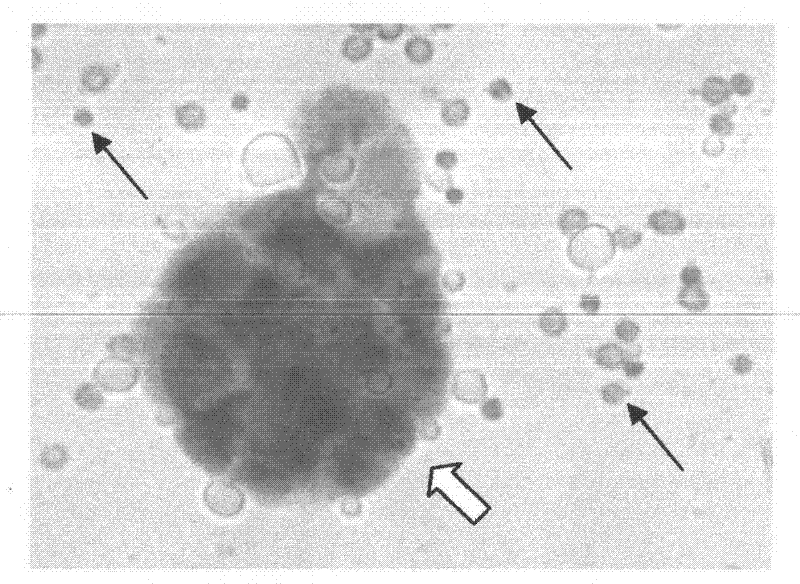Enzyme-labeling-liquid-based cytology staining kit for screening bladder cancer
A dyeing reagent and cytology technology, which is applied in the field of enzyme-labeled liquid-based cytology technology to screen bladder tumors, can solve the problems of heavy workload and high false negative rate, and achieve the effects of easy interpretation, clear shape, and maximized cell information
- Summary
- Abstract
- Description
- Claims
- Application Information
AI Technical Summary
Problems solved by technology
Method used
Image
Examples
Embodiment 1
[0041] 1. Enzyme-labeled liquid-based cytology staining kit components:
[0042] (1) Fixative: 10% formalin;
[0043] (2) ELISA liquid-based cytological staining solution: 2-30.5g / l naphthol AS-BI phosphate dissolved in dimethylformamide;
[0044] (3) Fuchsin hydrochloride: 1-10% fuchsin hydrochloride;
[0045] (4) Sodium nitrite: 0.1-0.5M NaNO 2 ;
[0046] (5) Sodium acetate solution: 1.5-4.5M, pH 4.5-5.9;
[0047] (6) Hematoxylin counterstaining solution;
[0048] (7) filter paper
[0049] 2. Preservation solution composition:
[0050] (1) 45% methanol;
[0051] (2) 0.2-0.5mM EDTA;
[0052] (3) 0.1mM NaCl;
[0053] (4) 0.1M acetate buffer, pH 4-6;
[0054] (5)dd H 2 O.
[0055] 3. Sedimentation buffer composition:
[0056] Recipe a:
[0057] 0.5XPBS, pH=7.0-7.4, 2-5mM EDTA;
[0058] Recipe b:
[0059] 10mM Tris-HCl pH=7.0-7.4, 2-5mM EDTA, 0.9% (m / v) NaCl.
[0060] 3. Sampling and operation
[0061] A. Conventional production
[0062] Collect 15 mL of mid-m...
Embodiment 2
[0075] Three cases of patients and healthy persons who have been clinically identified as bladder cancer, liver cancer, lung cancer, colorectal cancer, gastric cancer, and cervical cancer were selected. Urine samples were taken according to the method in Example 1, and enzyme-labeled liquid-based cytological staining was performed. The results showed that all three patients with bladder cancer had Figure 1-3 The cytoplasm in the urine was stained red, but no cytoplasm red stained in the urine samples of other cancer patients and healthy people.
[0076] The above test results show that the high expression of acid phosphatase detected in urine samples is highly specific to bladder cancer, and the method and kit of the present application can be used for screening diagnosis or assisting screening and diagnosis of bladder cancer patients.
Embodiment 3
[0077] Example 3 Effect test of enzyme-labeled liquid-based cytology preservation solution and sedimentation buffer
[0078] The bladder cancer cell line BIU-87 was preserved in the enzyme-labeled liquid-based cytological preservation solution described in this application and an existing preservation solution (purchased from Xiamen Maiwei Biotechnology Co., Ltd.) for 7 days, and then carried out with the sedimentation buffer. Film preparation and staining, the results obtained are as attached Figure 5 Shown, the preparation and staining effect ( Figure 5 A, 5B) The effect is significantly better than that of the control group cell preservation solution and sedimentation buffer (Xiamen Maiwei Biotechnology Co., Ltd., Figure 5 C). The specific comparison results are shown in the following table (more "+" means better effect):
[0079]
[0080] From this result, it can be seen that the enzyme-labeled liquid-based cytology preservation solution and the sedimentation buff...
PUM
 Login to View More
Login to View More Abstract
Description
Claims
Application Information
 Login to View More
Login to View More - R&D
- Intellectual Property
- Life Sciences
- Materials
- Tech Scout
- Unparalleled Data Quality
- Higher Quality Content
- 60% Fewer Hallucinations
Browse by: Latest US Patents, China's latest patents, Technical Efficacy Thesaurus, Application Domain, Technology Topic, Popular Technical Reports.
© 2025 PatSnap. All rights reserved.Legal|Privacy policy|Modern Slavery Act Transparency Statement|Sitemap|About US| Contact US: help@patsnap.com



